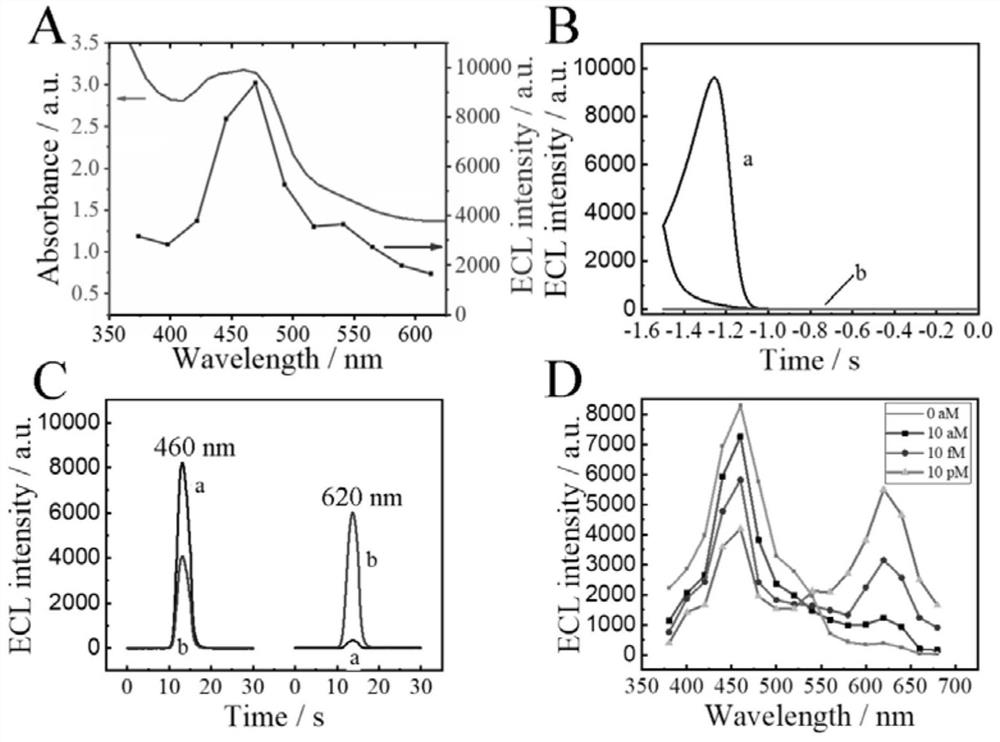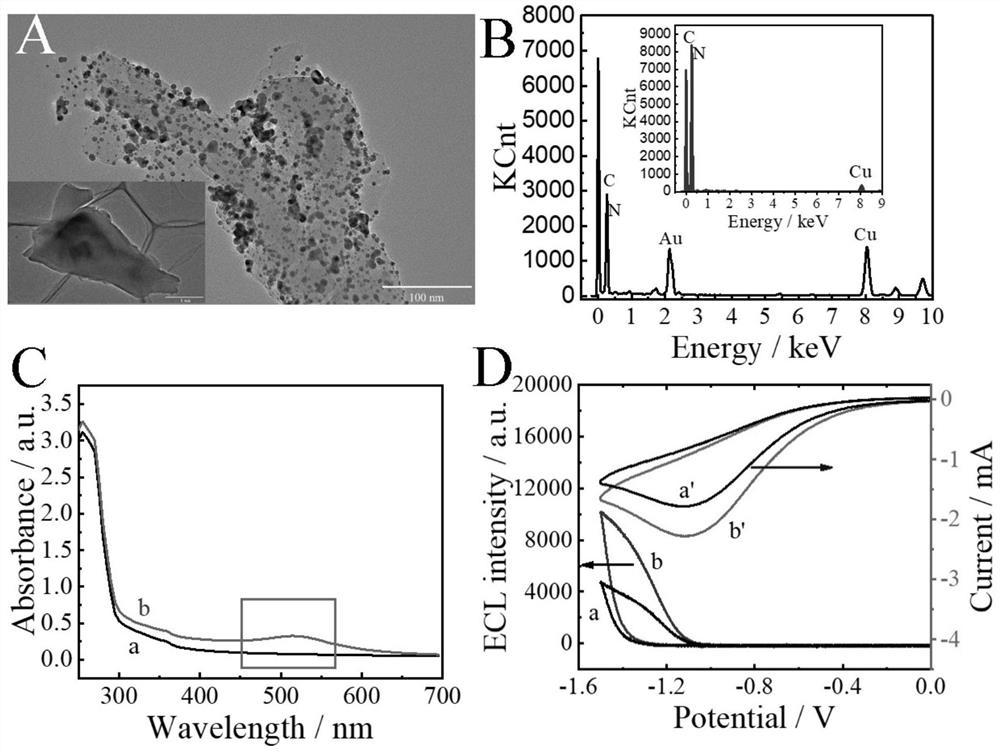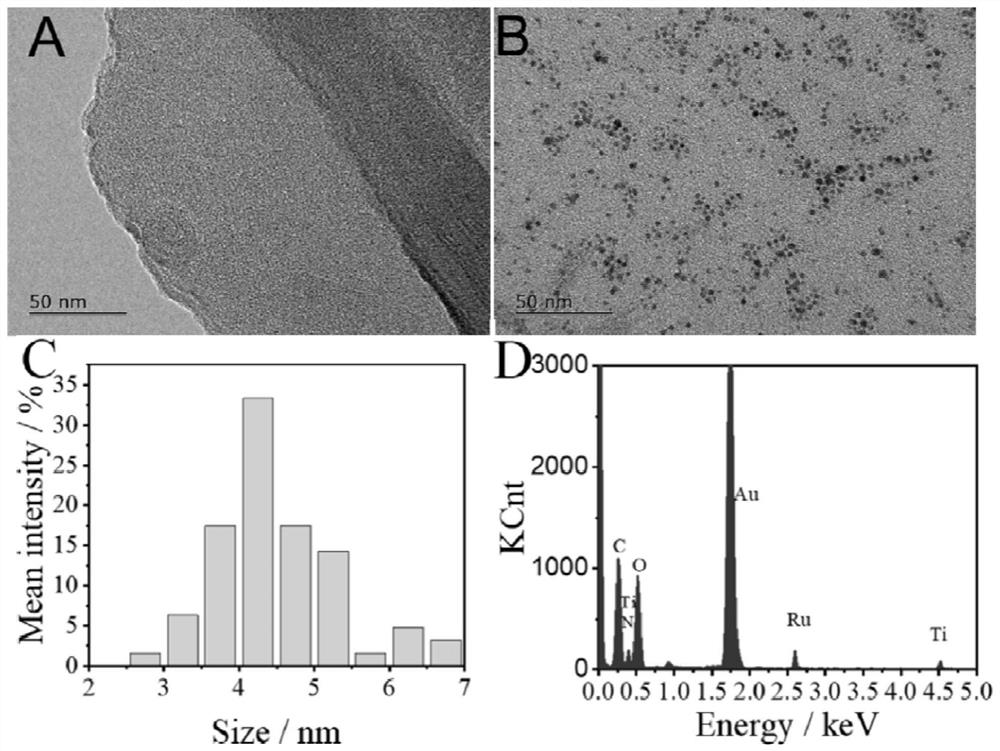Ratio-type ECL biosensor as well as preparation method and application thereof
A biosensor, the technology of SEQIDNO.8-SEQIDNO.10, is used in biochemical equipment and methods, microbial determination/inspection, resistance to vector-borne diseases, etc. And other issues
- Summary
- Abstract
- Description
- Claims
- Application Information
AI Technical Summary
Problems solved by technology
Method used
Image
Examples
preparation example Construction
[0062] Au-g-c 3 N 4 Preparation:
[0063] 50 μl of HAUCL 4 (0.01M) solution and 4 ml of G-C 3 N 4 (0.15mg ml -1 Mixed together, ultrasonic stirring for 10 minutes, then stirring for 1 hour. Then, 100 μl of fresh NABH is injected into the mixed solution. 4 (0.01 m) solution was treated in an ice bath for 20 minutes. A 50 μl of mass fraction was continuously added to the mixed solution of 1% sodium citrate solution, and the mixed solution was stirred at 25 ° C for 20 minutes. Finally, in order to remove excess Aunps, sodium citrate and NABH 4 , The above mixed solution was washed with ultrapure water with ultrapure water after centrifugation of 12000 rpm, and the sonication was treated 3 times to give pure Au-G-C. 3 N 4 Re-dispensed it in 1 ml h 2 O is preserved at 4 ° C for the next experiment.
[0064] Pei-Ru @ Ti 3 C 2 @ AUNPS-S7 probe synthesis Follow these steps:
[0065] 1, 10 mg of three (4,4'-dicarboxylic acid-2,2'-bispyridine) ruthenium (II) dichloride [RU (DCBPY) 3 2+ EDC...
Embodiment 1
[0073] Example 1 Composition of the ratio ECL biosensor and used to detect SARS COV-2RDRP genes
[0074] I. Comparison ECL biosensor construction method, including the following steps:
[0075] 1. Clean the glass carbon electrode (GCE). 10 μL of Au-g-C 3 N 4 Fixed on GCE to get AU-G-C 3 N 4 / GCE and dry at room temperature. Subsequently, Au-g-c will be obtained. 3 N 4 / GCE was soaked in a TDNAS (1 μM) solution containing 10 mm TCEP in a 10 mM TCEP to reduce the S-S bond. Next, the modified GCE was soaked in a 60 μl of MCH (100 μm) solution for 1 hour to prevent non-specific adsorption. In each of the above steps, the unconnected substance is required to be washed with a PBS solution. Will construct a good electrode (MCH / TDNAS / AU-G-C 3 N 4 / GCE) is stored in a fridge in 4 ° C for use with the next experiment.
[0076] 2, put MCH / TDNAS / AU-G-C 3 N 4 / GCE incubated in an entropy drive mixture of 37 ° C for 40 min, entropy-driven reaction mixture comprising different concen...
Embodiment 2
[0105] Example 2 Detect SARS-COV-2RDRP with a ratio ECL biosensor
[0106] 1. Under the optimum conditions of Example 1, the SARS-COV-2RDRP gene (detection method is seen in Example 1) was detected by the ratio ECL biosensor obtained in Example 1. Figure 7 A describes that as the SARS-COV-2RDRP concentration is increased from 10AM to 10 pm, the ECL signal strength decreases at 460 nm, and increases at 620 nm. Figure 7 A also describe the change in ECL signal strength at 460 nm has a good linear relationship, ie y = -502.82LGC (RDRP) -986.17, r 2 = 0.9944.620 nm ECL signal strength change also exhibits Y = 805.79LGC (RDRP) +14704.28 excellent linear relationship, R 2 = 0.9950. In order to obtain higher reliability, the increase in ECL (460 nm) / ECl (620 nm) of ECl (460 nm) / ECl (620 nm) is evaluated. Figure 7 B shows. According to the detection limit (LOD) = 3σ / k, the LOD is 7.8AM.
[0107] 2, the selectivity and stability of the ratio ECL biosensor (in Example 1)
[0108] In o...
PUM
 Login to View More
Login to View More Abstract
Description
Claims
Application Information
 Login to View More
Login to View More - R&D
- Intellectual Property
- Life Sciences
- Materials
- Tech Scout
- Unparalleled Data Quality
- Higher Quality Content
- 60% Fewer Hallucinations
Browse by: Latest US Patents, China's latest patents, Technical Efficacy Thesaurus, Application Domain, Technology Topic, Popular Technical Reports.
© 2025 PatSnap. All rights reserved.Legal|Privacy policy|Modern Slavery Act Transparency Statement|Sitemap|About US| Contact US: help@patsnap.com



